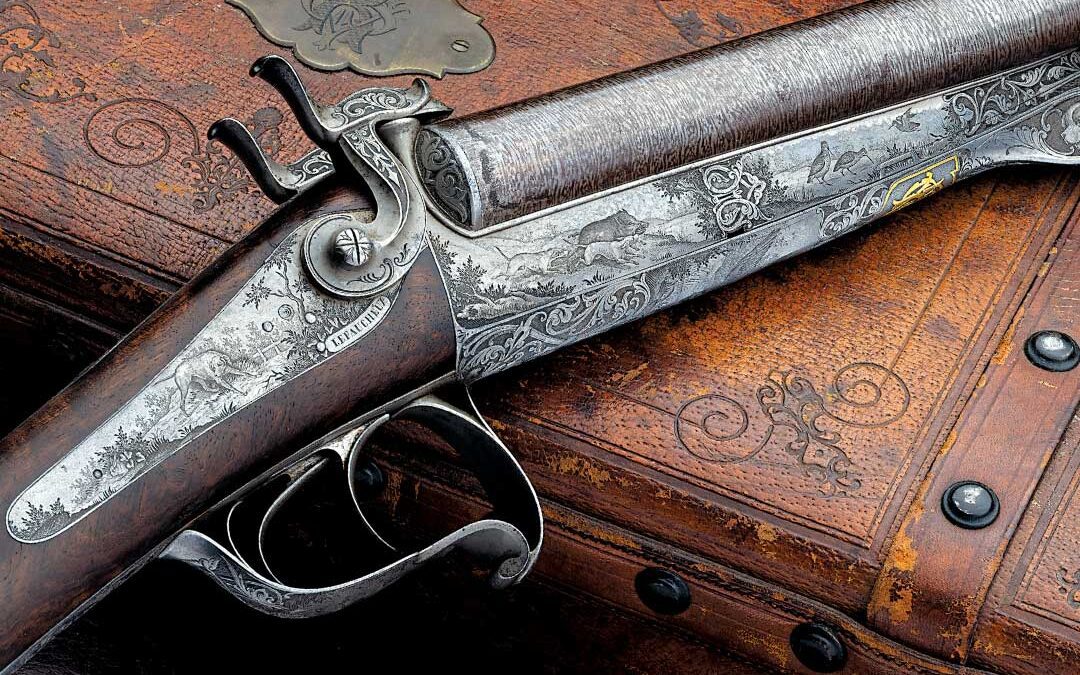Firearms, of a sort, are supposed to have been used before gunpowder was invented; but the history of sporting guns is not concerned with the prototypes of these early weapons, and they need not be specified. Nor do the early cannon devised for military purposes call for particular mention. Long after the days of Roger Bacon and the monk Schwartz, all firearms were far too clumsy and rudimentary to have been of use to the hunters of game.
A piece of iron shaped like a tun-dish was the first gun. Of this, the pipe is the powder chamber, and the widening muzzle—convenient for stone or ball of any size readily procurable—is the barrel. Experience proved that the strain from firing was exerted near the breech end, which in later specimens was strengthened by increasing the thickness of the metal there. The shot had to be directed, therefore the tun-dish was elongated into a tube. In order the more easily to manipulate the weapon, it was attached to a stout piece of wood. As a “fire-stick” it had a vogue. When used it might succeed as a gun, and if its shot missed the mark the weapon was still serviceable as a cudgel.
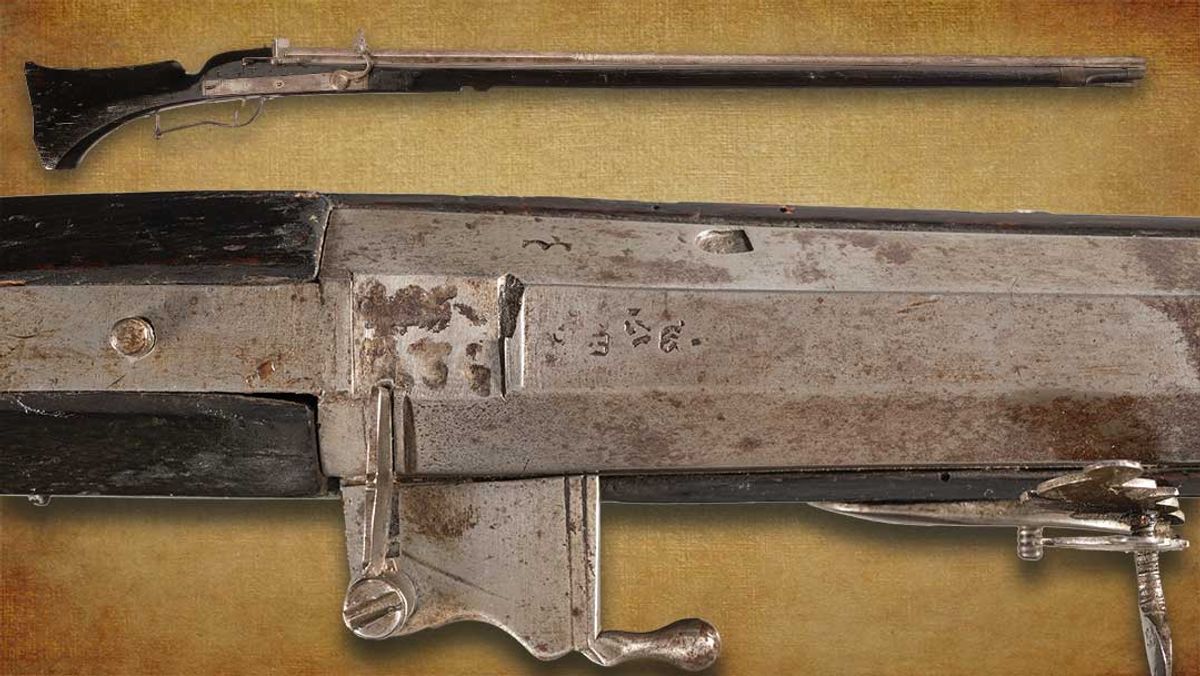
17th-century Spanish butt matchlock musket and rest.
This primitive firearm was useless for sport. From it the match-lock musket was slowly developed. First a spike was fitted near the breech, and to this the slow-match was attached, so as to be near at hand when the moment arrived for firing the gun. Then the spike became a movable holder, so that by a movement in one direction the match could be pressed upon the touch-powder. Next, the holder was pivoted; and then the hand that fired the gun was not necessarily removed from the stock, so was of use also in keeping the gun pointed toward the mark. Other devices were added to return the match from the touch-hole, and maintain it in position automatically. Later the touch-powder was placed in a pan at the side of the barrel instead of upon the top; the pan was covered to keep out the sparks and the wet, and when the pan-cover was also worked automatically by pressing the trigger, the match-lock was perfect.
The match-lock did not suit the purposes of the hunter, the difficulty of keeping the match alight being too great. A company of harquebusiers could keep the required fire going amongst them, and when about to engage the enemy could pass the light along the line from man to man; but that plan was not possible when hunting; so, although the match-lock gun was sometimes used for killing large game driven into nets, it did not supersede the crossbow as the general weapon of hunters.
Early in the 16th century, a German monk applied the principle of the flint and steel to firearms. The flint was pressed into the touch-pan by a spring. Through the pan a bar of roughened steel could be moved to and fro, and the sparks this friction engendered fired the gun. Almost immediately the gunmakers improved upon this by substituting for the bar a disk of steel, and rotating it automatically by means of another spring and chain. This disk was wound up with a key and held in position by a stop-peg withdrawn by pressure upon the trigger.
Such was the wheel-lock. Its mechanism was many times improved in various details, the changes following closely upon the progress made by the watchmakers of Nuremberg, the city in which originated this, the first firearm that can be ranked as a sporting gun. The wheel-lock was intricate, but not inefficient; it needed fine workmanship, so was costly. The Miquelitos, a band of marauders in the Pyrenees, are popularly supposed to have evolved the fire-lock from the wheel- lock. The burning slow-matches of the match-lock betrayed their whereabouts, and wheel-locks they could not procure; so they more closely approximated the action of striking fire with a flint and steel, directing the sparks into the touch-pan instead of the tinder-box. The result was the fire-lock with the mechanism outside the lock-plate, very much as used at the present time in the East. The first weapons on this principle appeared in Spain early in the 17th century; by 1640 they were common in Italy and France, and the new order of sporting, which was then coming into fashion, hastened their adoption.
Later improvements arranged the mechanism where it was better protected from blows and rain, lessened the liability to miss-fire and were directed toward rendering the arm serviceable for military purposes. These details it is needless to specify, nor is it possible to give here particulars of the many varieties of firearms devised at different times for specific purposes, or the multitudinous forms assumed by the sporting gun at different periods.
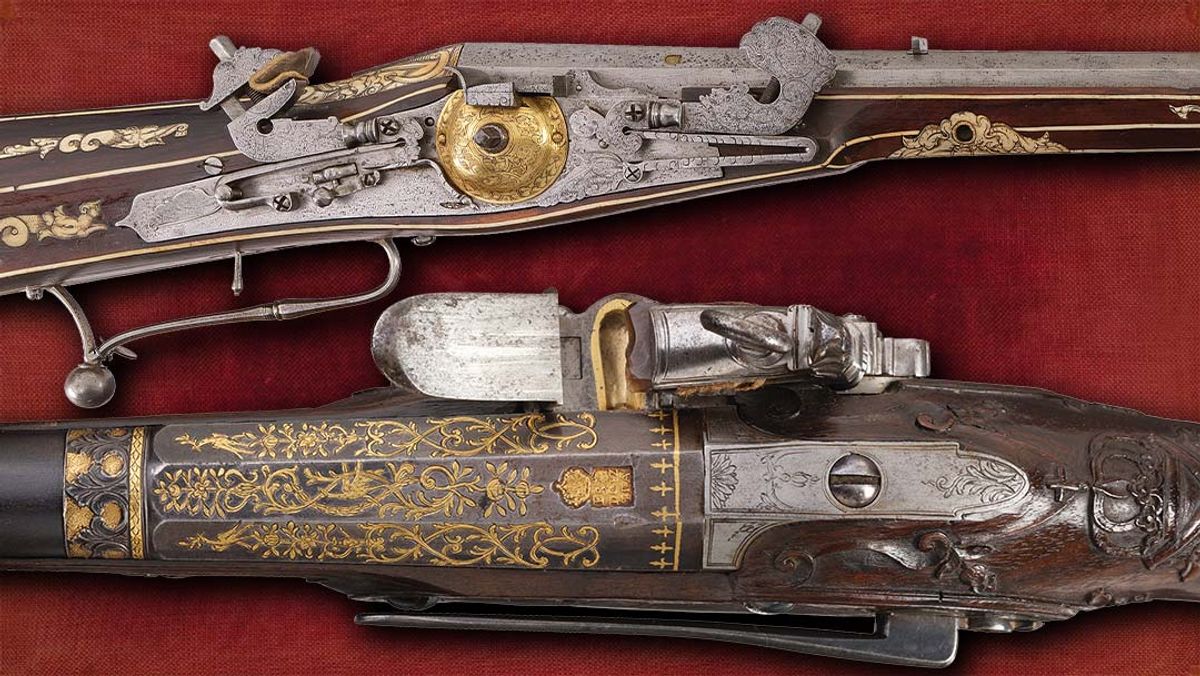
This late 16th century wheellock sporting gun features a large lock with two dogs that would allow a hunter to quickly get the gun back in action should the first pyrite fail. Courtesy Rock Island Auctions.
Rifling was discovered in Germany early in the 16th century, and the wheel-lock rifle quickly displaced the crossbow in that country. It followed closely the pattern of the weapon it superseded. Instead of the bolt used in the crossbow, the rifle fired at first a short cylindrical bar, and later a spherical ball, but not at a high speed, the ratio of the weight of the projectile to its velocity being such that the momentum of the ball allowed accurate shooting at short ranges. The sporting use of this rifle was confined to the killing of large game that had been hunted by dogs or driven by men after the fashion of the time. It was used instead of the spear, knife or crossbow to give the coup de grace to the animal already taken but was for a long time altogether too cumbrous and slow to be used with success on small animals or at game in rapid motion.
The smooth-bore musket was lighter and, in order to increase the shooter’s chances of hitting, was frequently loaded with two bullets, or three or more slugs instead of a ball. Then, for small game, it became customary to load with a couple of small metal tubes.
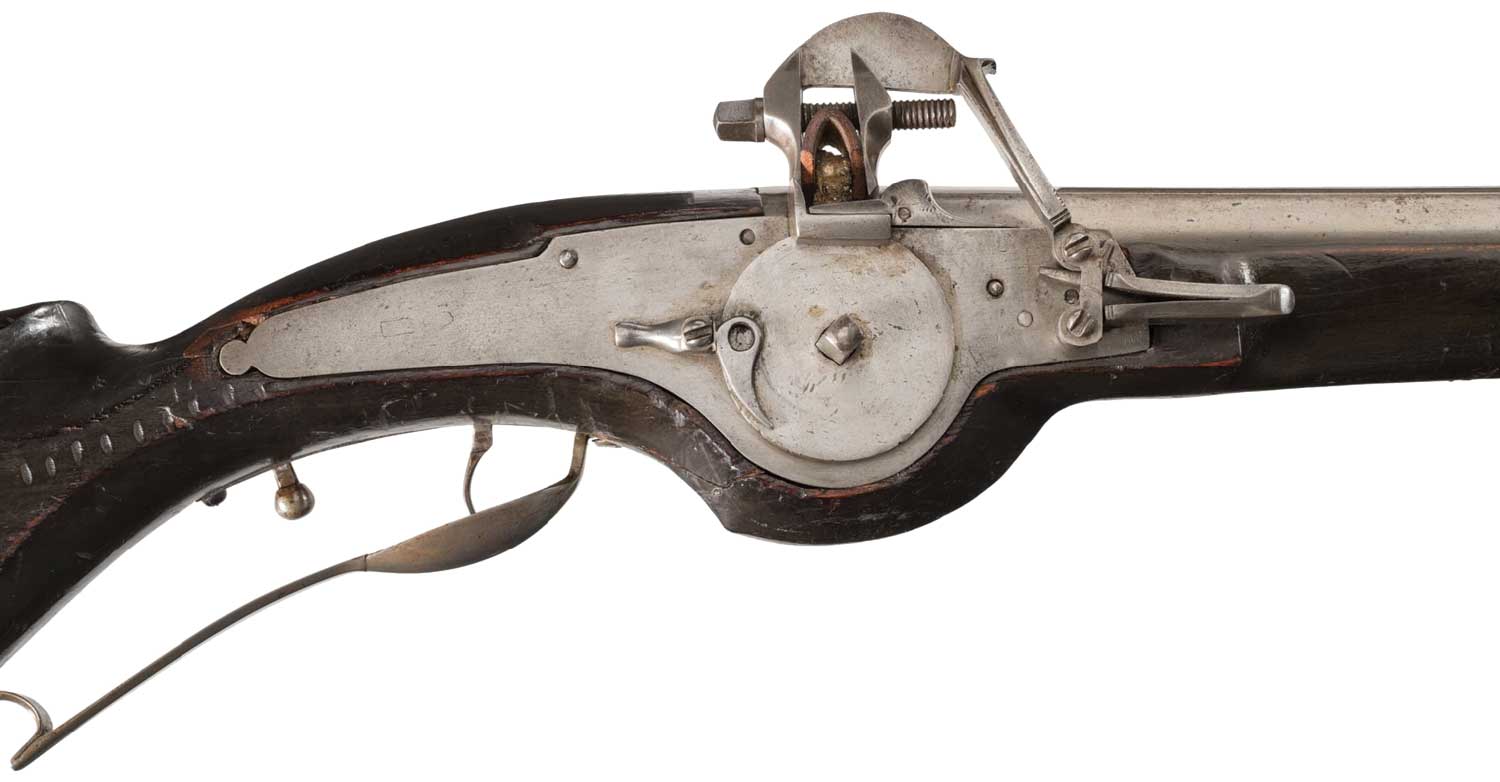
It was the superb work of the ’smiths that adapted the musket to the purposes of sport. The cleverness of these craftsmen is not easily estimated, but the closeness with which they forged is proved by the marks of the hammer and chase still visible upon the limbs of the lock mechanism of old arms. The barrels were, perhaps, not so closely forged, as it was important that when finished they should be wholly bright and smooth inside, whilst the outsides were also polished to make the detection of faulty welds possible.
The Spanish masters had the advantage. Possessing the purest iron and the finest steel, they made the best and lightest barrels. Their method was to weld small pieces together in order to get the fibers of the metal diversely distributed. By so doing, the tenacity of the iron was increased, and a lighter barrel became possible. Later, the fragments were first welded into strips, and these strips coiled and the joints welded together. Thus, was evolved the twist-barrel, which later became known as laminated steel, of which the “Damascus” metal is only a variety.
The old “ hand-gonnes” of war weighed about 40 pounds; the barrels were between four and five feet in length, and not less than an inch and a half in diameter. Milan “pieces” used for sport were not much smaller in the bore, but better workmanship and material allowed of the weight being reduced to 10 pounds or even less. At the close of the 18th century a barrel of 56 inches in length and of about 10 gauge was considered the best. Thus, the sporting gun of the period was very much like the military musket, the old “Brown Bess” of Wellington’s campaigns.
The next radical change was due to Napoleon’s restrictions on the trade in firearms. To prevent guns made on the Continent finding their way into the hands of his English enemies, he prohibited the manufacture, except for his own armies, of barrels of large gauge. The makers of the firearms consequently turned out sporting guns of 20 gauge and smaller, and what had been taken by sportsmen of necessity was subsequently acclaimed by them as correct, and adhered to from choice.
This undoubtedly accounts for the vogue small-bore guns had in Europe at the beginning of the previous century. It is possible that it had also another effect—the production of double-barreled guns. It is evident that a gun with two barrels of musket gauge placed side by side would be a cumbrous weapon. The few double guns made prior to this date were either curiosities or had the barrels placed one over the other—a plan Bossi, the Italian gunsmith of the 17th century, tried to make popular, with little success. It was on this plan, too, that Napoleon’s double sporting rifle was built.
When sportsmen were compelled to use a barrel of about half the capacity of that to which they had been accustomed, it is natural that they should endeavor to make good the deficiency by duplicating the parts. The double-barreled guns of small gauge were no more cumbrous than the single-barreled fowling-pieces of that age, and their advantages quickly established them in public favor.

Historic Cased Pair of John Manton & Son 16 Bore Double Barreled Percussion Shotguns. Courtesy Rock Island Auctions.
From that time the English gunmakers led the fashion in sporting arms. They improved the shotgun—stock, lock and barrel. The elevated rib connecting the two barrels was the invention of Joseph Manton, who also improved the breech and the ignition. His locks were of excellent workmanship, his safety devices to prevent accidental discharge, both when carrying and when loading the gun, were trustworthy, and his stocks were well shaped and tastefully ornamented. In short, the English shotgun at the commencement of the 19th century was of a model as good as any procurable today and, within its limits, as highly developed.
The chemist wrought the next change. A Scotch clergyman applied a fulminate to ignite the powder and dispensed with the flint and steel. But the percussion-cap gun was not evolved in a day, or in a decade of years. There were first guns made to use the fulminate when made up in the form of pilules, or amorces, or contained with the priming in tubes. The tinned-iron capsule preceded the copper cap, and it was not until half a century after the first discovery, and after many brains had been busy devising simple methods of applying the fulminate effectively, that the percussion gun attained any high degree of perfection.
Up to 50 years ago, there was little or nothing of gunmaking on scientific principles, but there was wonderful craft, as the best of these muzzleloading guns prove. Greener knew nothing of pressure curves, but by putting rings of lead at different distances along a barrel and altering the thickness of the barrel until firing it expanded all the rings to the same extent, he obtained that form for the outside of the barrel that has proved to be correct.
The workmanship also was improved. If a gun of the best Spanish or Italian make is compared with a modern percussion gun in such a detail as the breech, for instance, the advance made in a century is very marked. The earlier gun has merely a short plug screwed into the barrel. The later one has the barrel enlarged to take a plug of greater diameter; this plug is cupped out to hold the powder and is expanded by firing the gun; its edge also fits closely against the shoulder in the barrel; the screw- thread fits exactly throughout its entire length and the plug has upon it a flange that beds firmly against the very end of the barrel. With such a breech, it is quite impossible that there should be any discharge of the powder gases backward. If the nipple on which the cap is placed is screwed out, it will be found cupped, stoppered and fitted to the breech-plug in exactly the same way. The workmanship of the leading gunsmiths who built by hand 50 years ago has never been excelled and nowadays is seldom equaled. The finest specimens of their work are examples of the utmost that can be done by rule of thumb.
Whilst some gunmakers were congratulating themselves that their products had attained perfection, others endeavored to combine the newest method of ignition with the old, discarding the principle of loading at the breech. Here, once more, progress toward adequacy was slow. The flash of the fulminate, so strong when compared with the feeble spark from the flint on striking the steel, pierced ordinary cartridge paper, and manufacturers and inventors were hurrying into a cul de sac. The gun of the day had the military cartridge inserted in the barrel at the breech end, and the new percussion-cap sufficed to fire it. A wad at the base of the cartridge served as a gas-check, and this was pushed forward by the insertion of the next cartridge. Such was the capping-carbine of the mid-century wars.
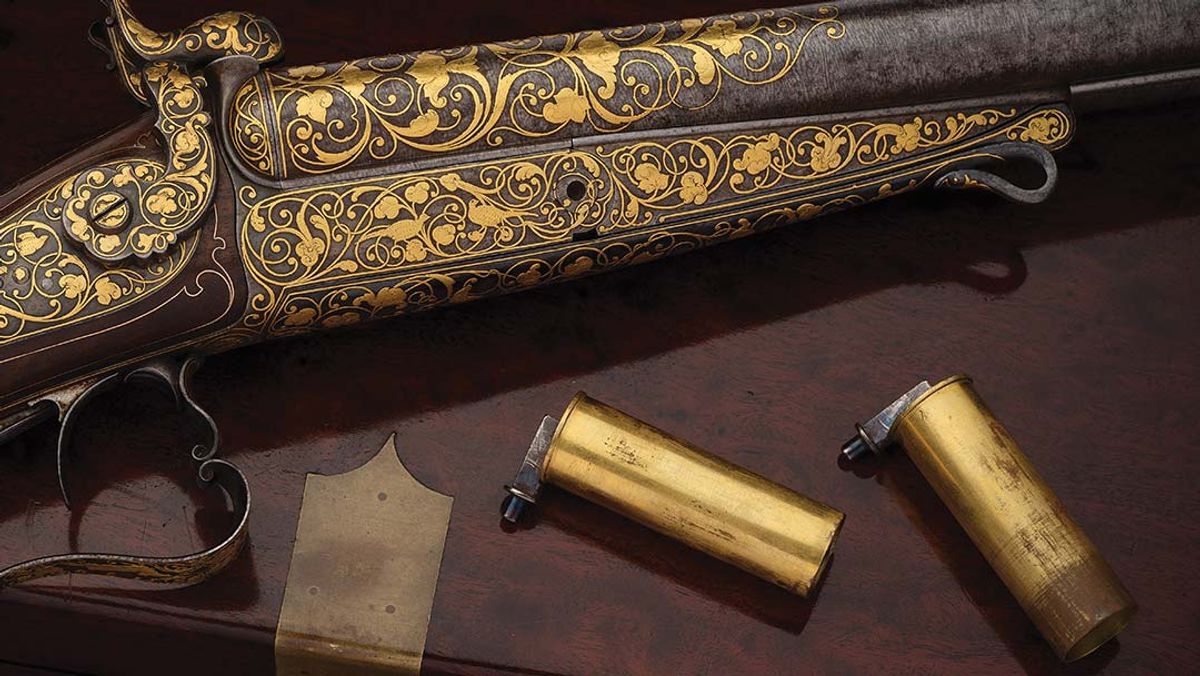
A dual ignition percussion/pinfire double barrel shotgun from Thomas of Paris.
Radical change resulted from the production of a cartridge that contained its own means of ignition. The origin of cartridges is lost in the obscurity of the far past. Very early the harquebusiers made up their charges separately; in the 16th century their use was common, but a cartridge containing its own ignition was new. In its earliest form, the detonator was in the shape of a tube attached to, or other protuberance extending from, the cartridge rather than within it. Then the cap was placed at the base of the projectile, and a striker pierced the soft case of the cartridge as well as the charge of powder, in order to reach and detonate it. The well-known Prussian needle-gun is upon this principle.
Houiller, a gunsmith of Paris, deserves the credit of inventing the modern cartridge. In 1847 he patented the pin-fire cartridge practically as it is today. As an alternative method he specified a rimfire cartridge and also one with central-fire ignition, but not the pattern now in use.
A cartridge case that contains its own ignition can be made gas-tight; more, by its expansion it acts as an obturator, and thus allows of breech-loading, as it prevents any escape of the powder gases through the joints of the breech mechanism when the gun is fired. It is the latest of the inventions that have revolutionized gunmaking.
The gunmakers of Paris were quick to benefit by Houiller’s discovery. Lefaucheux and Lepage both chose a modification of Pauly’s system of breech-loading for their guns, and Pauly’s system was but a slight alteration of that principle of hinging together of barrel and breech that had been used again and again in various countries during the centuries in which the art of the gunmakers flourished on the continent of Europe.
Other methods were revived and devised, but for the purposes of the sportsman, the drop-down principle answered best and has survived all others.
Schneider, Pottet, Daw and gunmakers English and foreign, improved the central-fire cartridge, which slowly but surely superseded the pin- and rimfire systems. The central-fire Lefaucheux gun was but little better than the pin-fire, and for some years the chief improvements in guns were all concerned with perfecting the breech mechanism, and directed towards giving greater strength and durability to the parts, and only later toward producing a gun that allowed of easier and quicker manipulation of the action. A double bolt for a single one to unite barrels and action was a notable improvement; a third bolt, across and at the top, was better again—so much better—that beyond it no one has found it possible to go. The locks were improved and made to rebound so as to relieve the detonating cap of all pressure save just when struck. Then came hammerless guns, and the rebounding lock was useless.
Of rival hammerless guns much might be written, but at the present time all that can be positively asserted is that those mechanisms are the best in which the cocking of the locks is accomplished automatically. So much also may be asserted in respect of the ejecting mechanisms for throwing out the cartridge that has been fired. The best will be that which does its work without requiring any conscious effort of the shooter and utilizes to the full extent the weight of the barrels in falling as the gun opens.
Choke-boring, which if it did not originate in America was successfully developed there, is a discovery of the very first importance, since it not only increases the efficiency of the gun, but enables the gunmaker to control its actual performance. Choke-boring also has made gunmaking more of a science and less of a craft.
Probably no article in use today has been brought to its present state through so long a period and with so many radical changes as the modern shotgun. Almost each type of gun has been developed to its highest state of perfection little by little, and each perfected type of the past has fallen into desuetude owing to some change of principle which, whilst it has altered the type, has also lowered the gun in some particular from the degree of excellence the best of its class had attained.
At present there is no indication of any great change being imminent; if any notable alteration should come quickly, doubtless it will be in respect of some detail concerning which change is now least expected. But it must not be supposed that modern guns of the prevailing type are perfect; each season some slight improvement is made—and others are needed.
It may be stated that the gun of the near future will be very like that of today, but there will be less gun. The use of concentrated nitros allows of a shorter cartridge case. Instead of packing the ordinary case with additional wadding, the sensible thing to do is to shorten the case, thus shorten the chamber, and consequently the barrels and the gun. Possibly, too, guns can be built closer than they are at present; the breech ends of the barrels brought nearer to the butt-plate, the gun made to balance farther back, and so be more easily raised to the firing position and more quickly aligned. Minor improvements only are such as these, when compared with the great changes of the past; they nevertheless are apparently the changes that will hasten the development of the sporting gun.
This article originally appeared in the February 1901 issue of Outing magazine.

